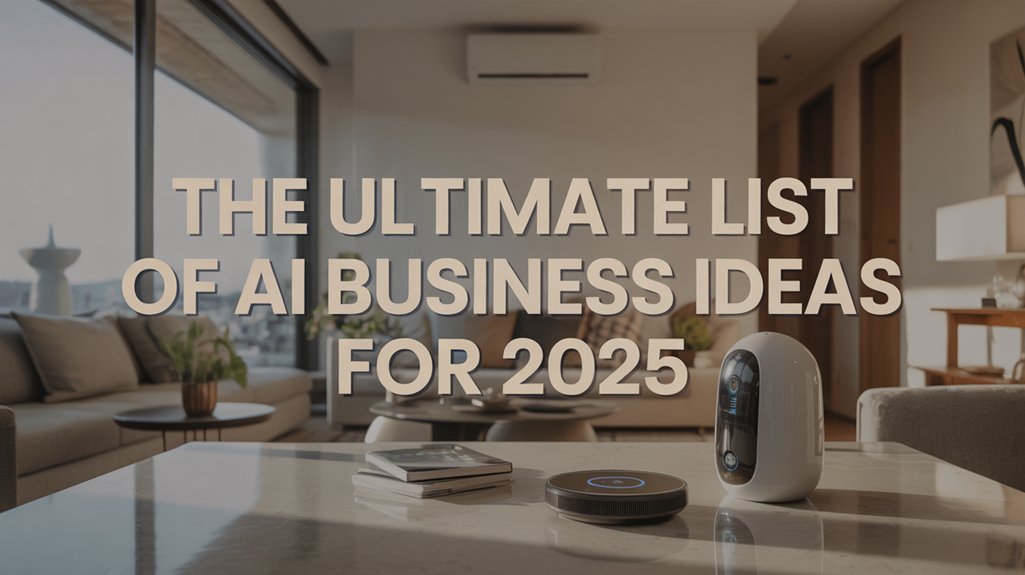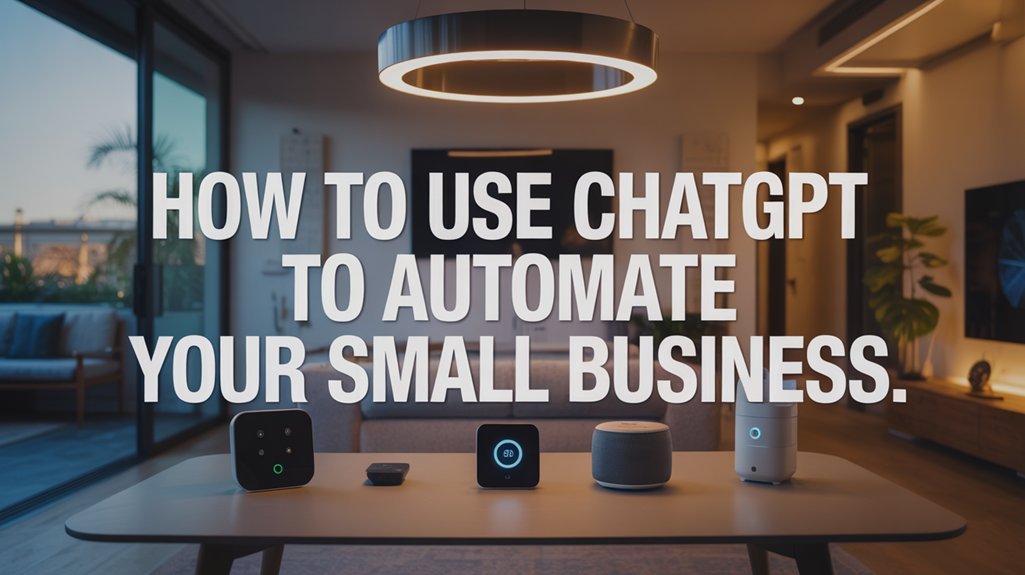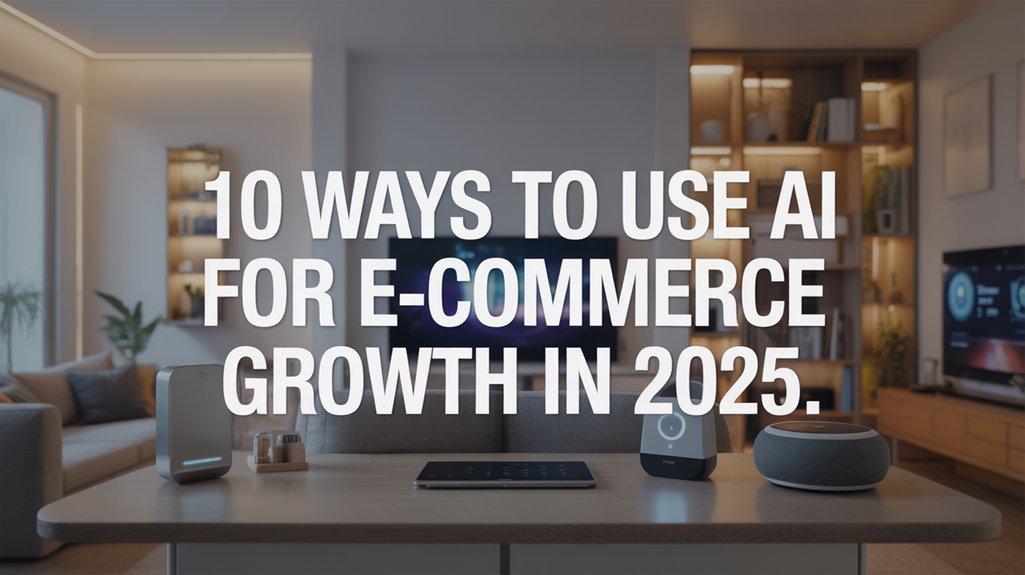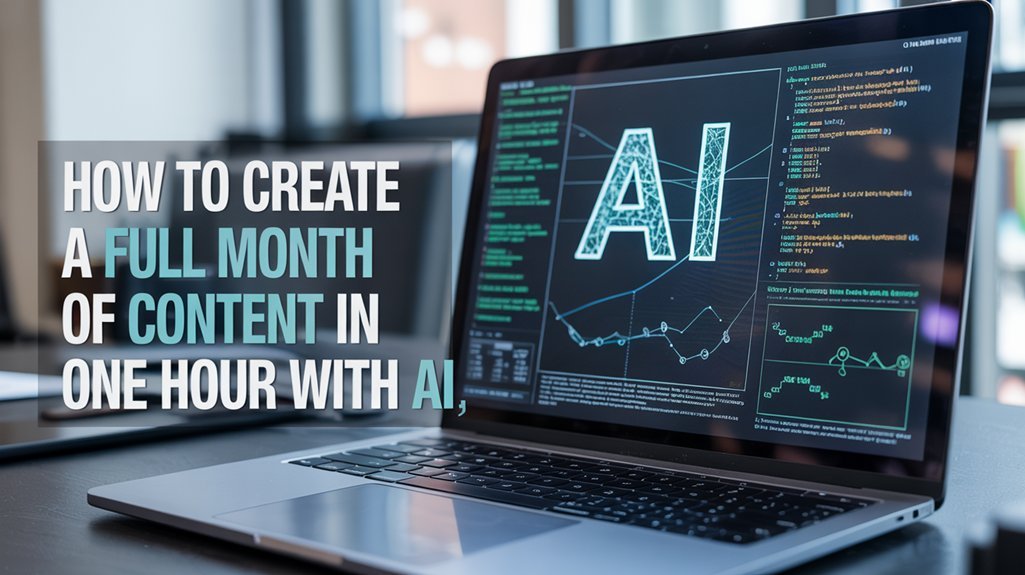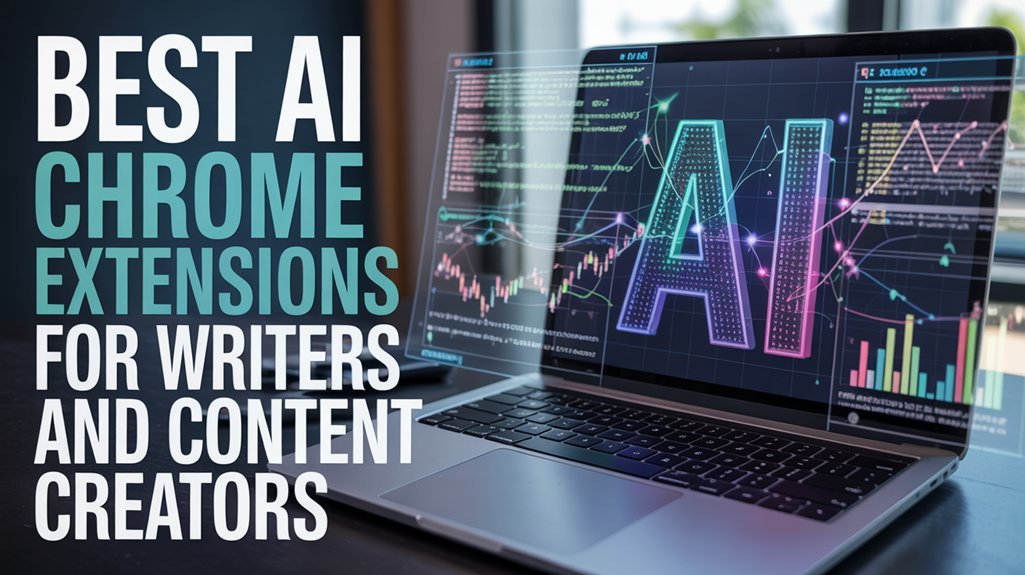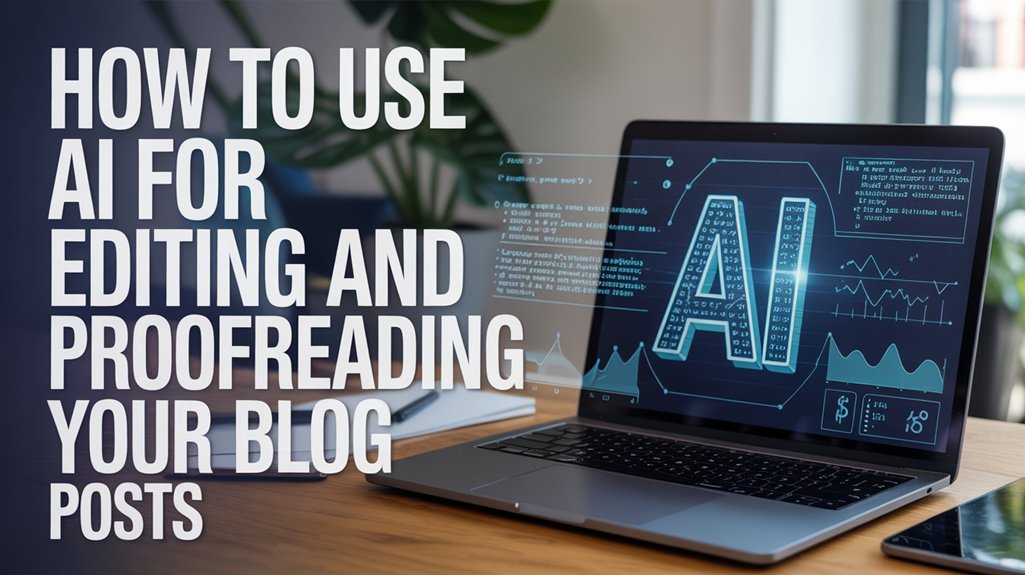You'll find exceptional opportunities in AI-powered fraud detection (30% reduction in fraudulent activities), virtual health assistance ($45.2 billion market by 2026), and personalized education platforms tapping into the $375 billion e-learning sector. You can also take advantage of AI-driven supply chain optimization that cuts inventory costs by 30%, financial advisory services democratizing wealth management, and AI influencers capturing the booming digital marketing space. The thorough breakdown below reveals exactly how you'll implement these high-ROI ventures before market saturation arrives.
Key Takeaways
- AI-powered fraud detection systems reduce fraudulent activities by 30% while cutting false positives by 50% through real-time monitoring.
- Virtual health assistants can reduce healthcare costs by 30% while delivering personalized advice and chronic disease management solutions.
- AI-based education platforms tap into the $375 billion e-learning market with personalized learning paths and automated administrative tasks.
- AI supply chain optimization cuts inventory costs by 30% and achieves 20% faster deliveries through intelligent forecasting and routing.
- AI influencer marketing platforms offer brands predictable, scalable strategies in an exponentially growing digital marketing landscape.
Why Launch Your AI Business in 2025?
While many entrepreneurs wait for the “perfect moment” to launch, 2025 presents a convergence of market conditions that won't repeat itself.
You're looking at a $390.9 billion market where 78% of companies will deploy AI technologies—creating unprecedented AI business opportunities for those ready to seize.
The COVID-19 pandemic permanently accelerated digital evolution, leaving organizations hungry for implementation support.
Here's your advantage: most companies lack the expertise to deploy AI effectively. You'll fill a massive gap between technological capability and practical application.
Advanced natural language processing and machine learning have democratized AI development.
You can now build sophisticated solutions without massive infrastructure investments. The barrier to entry has collapsed while market demand has exploded.
Your competitors are still deliberating.
Smart money moves now, capturing market share before saturation. The AI technologies landscape rewards first movers who execute decisively.
From generative AI models transforming creative workflows to autonomous systems reshaping industries, the technological foundation for innovation has never been stronger.
Position yourself at the intersection of urgent business needs and emerging capabilities—that's where fortunes are built.
AI-Driven Fraud Detection Solutions
You'll need strong real-time transaction monitoring systems that analyze millions of data points per second to catch fraudulent activities before they impact your bottom line.
Your AI solution should incorporate pattern recognition technologies that learn from historical fraud cases while continuously updating their models to identify emerging threat vectors.
By harnessing AI effectively, you can transform your fraud detection capabilities into a strategic advantage that protects revenue while maintaining seamless customer experiences.
Real-Time Transaction Monitoring
Financial institutions lose billions annually to fraud, yet AI-driven transaction monitoring systems now catch suspicious activity in milliseconds—before the damage occurs.
You'll dominate this market by deploying AI technology that analyzes millions of real-time transactions simultaneously, flagging anomalies traditional systems miss. Your algorithms will detect pattern deviations, velocity changes, and behavioral inconsistencies across payment channels instantly.
The competitive advantage? Automated fraud detection eliminates human latency while processing transaction data at scale. You'll reduce false positives by 60% through machine learning models that adapt to emerging fraud tactics continuously.
Implementation requires minimal infrastructure—cloud-based solutions integrate with existing payment systems within weeks. Your clients gain immediate ROI through prevented losses, reduced operational costs, and regulatory compliance.
As business AI coverage continues to expand, early adopters of these technologies are establishing themselves as industry leaders in financial security.
The trajectory is clear: businesses deploying real-time monitoring will outmaneuver competitors still relying on legacy detection methods.
Pattern Recognition Technologies
Because traditional rule-based systems can't keep pace with evolving fraud schemes, pattern recognition technologies represent your competitive edge in 2025's fraud detection landscape.
These AI solutions analyze transaction patterns to identify anomalies with unprecedented accuracy, delivering up to 30% reduction in fraudulent activities across your operations.
Machine learning algorithms continuously adapt to emerging threats, recognizing new fraud patterns as they develop.
You'll cut false positives by 50%, accelerating legitimate transactions while maintaining ironclad security.
With cyber fraud techniques advancing rapidly, the 20% surge in demand for AI-powered fraud detection reflects strategic necessity, not optional innovation.
Deploy these solutions to convert raw transaction data into actionable intelligence, positioning your enterprise ahead of sophisticated threats while competitors struggle with outdated systems.
Modern enterprises increasingly leverage multi-tool search capabilities to enhance their fraud detection systems, enabling simultaneous analysis across multiple data sources and detection methods.
AI-Powered Virtual Health Assistance

As healthcare systems worldwide grapple with rising costs and provider shortages, AI-powered virtual health assistants are emerging as a groundbreaking solution that's reshaping patient care delivery.
You're positioned to capture significant market share in an industry projected to reach $45.2 billion by 2026.
Deploy AI-powered virtual health assistance platforms that utilize advanced algorithms to deliver personalized health advice, automate medication reminders, and enable continuous remote monitoring.
You'll reduce healthcare costs by up to 30% while dramatically improving patient outcomes.
The pandemic accelerated telehealth adoption by 38%, creating unprecedented demand for scalable virtual care solutions.
Your AI systems will analyze patient data in real-time, enabling proactive chronic disease management and precision interventions.
Focus on building platforms that enhance patient engagement and treatment adherence.
You'll drive measurable results: better health outcomes, higher satisfaction rates, and sustainable competitive advantage in a rapidly expanding market where early movers dominate.
AI-Enhanced Culinary Experience Apps
Every day, millions of home cooks struggle with the same challenges: what to prepare for dinner, how to accommodate family dietary restrictions, and whether they're actually meeting their nutritional goals.
AI-driven solutions are reshaping this landscape into a lucrative market opportunity projected for exponential growth through 2025.
You'll harness machine learning algorithms that analyze user behavior patterns to deliver personalized meal plans tailored to specific dietary needs—keto, vegan, gluten-free, or allergen-specific restrictions.
Your platform will feature virtual cooking assistants that guide users through complex techniques in real-time, while simultaneously tracking nutritional intake with precision.
The implementation framework is straightforward: develop algorithms that learn from user preferences, integrate with smart kitchen devices, and provide actionable cooking guidance.
You're entering a market where convenience intersects with health consciousness, positioning yourself to disrupt traditional meal planning.
This isn't just another food app—it's a scalable AI business that solves daily problems for millions while generating recurring revenue.
AI Influencers and Marketing Solutions

While traditional influencer marketing demands constant negotiations, scheduling conflicts, and unpredictable human behavior, AI-generated influencers operate 24/7 with zero overhead costs and complete brand alignment.
You'll control every aspect of your digital spokesperson—appearance, messaging, and audience interaction—without the liability risks human influencers present.
Deploy AI influencers like Lil Miquela demonstrates: build a character with calculated appeal, then utilize data analytics to engineer marketing solutions that convert.
Your AI-driven platform analyzes consumer behavior patterns, automatically generating personalized campaigns that adapt in real-time based on engagement metrics.
The implementation path is straightforward: develop proprietary AI influencers for brands lacking in-house capabilities, or create a SaaS platform enabling companies to generate custom digital personalities.
You'll capture market share in an industry projected for exponential growth, positioning yourself as the architect of next-generation influencer marketing where predictability, scalability, and ROI trump the chaos of human-dependent strategies.
AI-Powered Gaming Startups
AI influencers monetize through brand partnerships, but the gaming industry offers a more scalable revenue model through direct-to-consumer engagement.
AI-powered gaming startups command a share of the $200+ billion global market by deploying machine learning algorithms that create adaptive storylines responding to player decisions in real-time.
You'll take advantage of this opportunity by implementing predictive analytics to analyze player behavior patterns, enabling you to enhance game mechanics and deliver personalized gameplay experiences that increase retention and lifetime value.
Your competitive advantage lies in developing NPCs with advanced AI that execute realistic, responsive interactions rather than scripted responses.
DeepMind's AlphaStar validates this approach—AI systems now compete at professional levels in strategic games like StarCraft II.
You'll utilize similar technologies to build games that adapt difficulty curves, generate unique content paths, and predict player preferences before they articulate them, creating unprecedented engagement that translates directly into recurring revenue streams.
Personalized AI-Based Education Platforms

Although gaming platforms generate revenue through engagement loops, personalized AI-based education platforms tap into the $375 billion e-learning market by 2026 with direct institutional contracts and B2C subscriptions.
You'll deploy machine learning algorithms that construct tailored learning paths matching individual cognitive profiles, processing styles, and performance metrics in real-time.
Your adaptive tutoring systems will deliver instantaneous feedback and targeted interventions, driving measurable improvements in retention and completion rates. The competitive advantage lies in automating administrative overhead—grading, progress tracking, compliance reporting—freeing educators to execute high-value instruction.
Your AI-driven education tools will analyze behavioral and performance data to pinpoint knowledge gaps, then prescribe specific resources and remediation strategies. This creates a closed-loop system where each interaction refines the learning model.
Position yourself to capture enterprise contracts with universities and corporate training divisions, while scaling consumer subscriptions through demonstrated outcomes. Personalized learning isn't supplementary—it's the infrastructure that separates market leaders from obsolete competitors.
AI-Driven Supply Chain Optimization
You'll change your supply chain operations in 2025 by implementing AI systems that cut inventory costs by 30% through precise demand forecasting.
Machine learning algorithms will automate your inventory management while reducing manual processing errors by 50%, freeing your team to focus on strategic decisions.
Your logistics network will achieve 20% faster deliveries and lower transportation costs through intelligent route optimization that adapts to real-time conditions.
Demand Forecasting With AI
When your business struggles to balance inventory levels with actual customer demand, you're leaving money on the table through tied-up capital and lost sales.
AI-driven demand forecasting alters your supply chain from reactive to predictive, delivering 30% improvement in forecast accuracy while slashing excess inventory costs by 20%.
Machine learning algorithms process historical sales data, seasonality patterns, and economic indicators in real-time, enabling you to anticipate market shifts before competitors react.
You'll minimize stockouts that damage customer relationships while eliminating wasteful overstock that drains resources.
The supply chain AI market reaching $10 billion by 2025 signals serious competitive advantage for early adopters.
Deploy these systems now to command market position through superior resource allocation and customer satisfaction metrics that leave traditional forecasting methods obsolete.
Inventory Management Automation
Predictive demand forecasting loses its value if you can't execute on the insights—which is where AI-powered inventory management automation alters your supply chain from data-rich to action-ready.
When you automate inventory management with machine learning algorithms, you're not just tracking stock—you're orchestrating a synchronized operation that slashes excess inventory by 30% while cutting warehousing costs by 20%.
AI systems deliver three critical advantages:
- Real-time multi-location visibility that reduces stockouts by 50% across your entire network
- Automated replenishment triggers that compress lead times by 25%, strengthening your competitive positioning
- Dynamic order processing that boosts fulfillment rates by 10-15%, directly impacting customer retention
Supply chain optimization through AI converts reactive inventory practices into predictive control systems that respond before disruptions materialize.
Route Optimization Systems
While your inventory sits perfectly improved, bottlenecks in last-mile delivery will erode those gains—which is why AI-driven route improvement systems revolutionize logistics from a cost center into a profit accelerator.
AI-driven route enhancement slashes transportation costs by 20% through real-time analysis of traffic, weather, and historical patterns. You'll flexibly reroute around obstacles, compressing delivery windows while elevating customer satisfaction scores.
Superior fleet management emerges when machine learning refines vehicle utilization and minimizes fuel consumption—directly impacting your bottom line. The system continuously learns from each delivery, adapting to evolving conditions and compounding operational efficiency gains.
With logistics markets approaching $15 trillion by 2027, you're not implementing software—you’re capturing market share. Deploy these systems now, and you'll dominate supply chain performance while competitors hemorrhage margin on outdated routing.
AI-Enabled Financial Advisory Services
As traditional financial advisory fees continue to price out middle-income investors, AI-enabled financial advisory services are democratizing wealth management through algorithmic precision and 24/7 accessibility.
You'll capture market share by deploying AI financial advisors that analyze vast datasets to deliver personalized investment recommendations tailored to each client's risk tolerance and financial objectives.
Your platform should automate financial planning through these core capabilities:
- Real-time portfolio optimization using machine learning algorithms that adapt to volatile market conditions and rebalance holdings automatically.
- Behavioral analysis engines that detect spending patterns and generate practical recommendations to improve financial literacy and decision-making.
- Continuous budget monitoring with intelligent alerts that keep clients aligned with their wealth-building targets.
Frequently Asked Questions
What Is the Best AI Business to Start in 2025?
You'll dominate by launching an AI-driven marketing platform that integrates personalized customer service with intelligent supply chain optimization.
This trifecta addresses critical pain points across industries, positioning you at the intersection of three high-growth markets.
You're looking at massive ROI potential—companies need automation that delivers real results.
Focus on predictive analytics and smooth implementation.
The data's clear: businesses investing in extensive AI solutions outperform competitors by 40%.
Strike now while market gaps remain.
What Business Will Be Booming in 2025?
You'll dominate in 2025 by targeting three explosive sectors: sustainable tech solutions that help companies cut carbon emissions and energy costs, remote work infrastructure that enhances distributed team productivity, and personalized healthcare platforms delivering AI-driven diagnostics and telehealth services.
These markets aren't just growing—they're converging with the $1.6 trillion AI opportunity. You'll capture maximum ROI by integrating predictive analytics and automation into these high-demand verticals where consumers and enterprises are actively investing.
What Will Be the AI Breakthrough in 2025?
You'll witness groundbreaking AI advancements impact across multiple sectors in 2025.
Healthcare will lead with diagnostic accuracy improvements exceeding 30%, while ethical AI considerations become non-negotiable for market leaders.
You'll utilize predictive analytics that cut operational costs by 50% and deploy hyper-personalized systems that dominate consumer engagement.
The real breakthrough isn't single technology—it's your ability to integrate AI in healthcare, manufacturing, and consumer touchpoints simultaneously, creating insurmountable competitive advantages through data-driven implementation strategies.
What Are Good AI Businesses to Start?
You'll dominate by launching AI Consulting Services that change legacy operations into intelligent systems.
Automated Content Creation platforms position you to capture the explosive demand for scalable, personalized marketing assets.
Predictive Analytics Solutions give you control over untapped markets—anticipate customer behavior, refine pricing, and eliminate waste before competitors react.
You're positioned to command premium rates because businesses desperately need implementation expertise.
Focus on industries drowning in data but starving for actionable intelligence.
That's where you'll build unstoppable momentum.
Conclusion
You've explored the landscape where algorithms meet opportunity. Now it's time to plant your flag in this fertile ground. The data tells us AI will contribute $15.7 trillion to the global economy by 2030—you'll want your slice of that pie. Pick your niche, validate your approach, and build your minimum viable product. The window won't stay open forever. Tomorrow's market leaders are implementing today. Your move.

